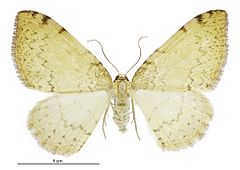Epiphryne undosata facts for kids
Quick facts for kids Epiphryne undosata |
|
|---|---|
 |
|
| female | |
 |
|
| male | |
| Scientific classification | |
| Kingdom: | |
| Phylum: | |
| Subphylum: | |
| Class: | |
| Order: | |
| Family: | |
| Genus: |
Epiphryne
|
| Species: |
E. undosata
|
| Binomial name | |
| Epiphryne undosata (Felder & Rogenhofer, 1875)
|
|
| Synonyms | |
|
|
The Epiphryne undosata is a type of moth that belongs to the Geometridae family. These moths are special because they are endemic to New Zealand. This means you can only find them living naturally in New Zealand and nowhere else in the world!
Discovering the Epiphryne undosata
This interesting moth was first officially described in 1875. Three scientists, Baron Cajetan von Felder, Rudolf Felder, and Alois Friedrich Rogenhofer, gave it the name Cidaria undosata back then. Scientists often change names as they learn more about different species.
What Does the Epiphryne undosata Look Like?
The Epiphryne undosata moth is quite small. When its wings are spread out, it measures less than an inch across. All of its wings are a pale yellow color. They have a few thin, zig-zag lines that are reddish-brown. These lines are usually clearest near the outer edges of the wings.
The front wings have a wide reddish-brown band along their top edge. There's also a small black dot in the middle, right next to this band. Near the tip of the front wings, you might see a tiny brown mark. The back wings have a very small black dot a little above their middle.
Life Cycle and Food Sources
Adult Epiphryne undosata moths play an important role in nature. They visit the flowers of certain plants to feed. While they are feeding, they also help to pollinate these plants. This means they help the plants make seeds and grow new plants.
The moths especially like to feed from the flowers of two native New Zealand plants: Dracophyllum acerosum and Hebe salicifolia.

